Национальный парк Мегиддо – Путеводитель с фотографиями
Национальный парк Тель-Мегиддо на севере Израиля позволяет увидеть остатки древнего города Мегиддо (Армагеддон).
Оглавление
Мегиддо и Национальный парк Тель-Мегиддо
Мегиддо был древним городом, известным своими историческими, географический, и богословское значение, особенно под греческим названием Армагеддон. Этот список Всемирного наследия стал Мегиддо Национальный парк. Так для туристических и туристических целей, Мегиддо и национальный парк Тель-Мегиддо - это одно и то же.
А вот небольшой видеоролик об этом сайте на YouTube:
Карта и маршруты
Национальный парк Тель-Мегиддо расположен недалеко от кибуца Мегиддо на севере Израиля в долине Изреель..
Направления для водителей: Ссылка на Вейз и Ссылка на карты Google
Направления общественного транспорта: Ссылка на Моовит
Интерактивная карта местности:
А вот карта национального парка:
Примечание: Вы можете нажать на изображение, чтобы увеличить его.
Если вы доберетесь до национального парка на общественном транспорте, Вам следует сесть на автобус до перекрестка Мегиддо. Среди крупнейших израильских городов, Хайфа ближе всего один. Вы можете добраться до Мегиддо перехода из Хайфы с помощью шины #248. Если вы приедете из Тель-Авив, Вы можете сесть на автобус #825 (Тель-Авив – Линия Афула). В любом случае, для направления, используйте следующую ссылку, чтобы Moovit. Обновите начальную точку, и вы получите обновленные направления.
Вы можете использовать навигационное приложение, чтобы проложить маршрут, если у вас есть автомобиль. В Waze, тип Национальный парк Тель-Мегиддо, и вы получите там. На территории есть бесплатная парковка..
Часы работы
Воскресенье - четверг и суббота: 8:00 - 17: 00 (зимой 16:00).
Пятница: 8:00 - 16: 00 (15:00 зимой).
В канун праздника, как правило 8:00 - 13:00.
Примечание: после пандемии, Управление природы и парков Израиля начало ограничивать количество людей в каждом парке. Таким образом, бронирование рекомендуется через официальный сайт (вы можете найти ссылку ниже).
Входная плата
Взрослый – 28 шек, ребенок – 14 шек, и студент – 24 шек. Бесплатно для годовых подписчиков Национальных парков.
Если вы посетите несколько национальных парков, подумайте о покупке комбо-билета. Для получения дополнительной информации, смотрите Национальные парки и заповедники.
Примечание: часы работы и цены на билеты были обновлены в октябре. 2022. В любом случае, перепроверьте официальный сайт перед посещением.
Что означает Тель?
Древний город Мегиддо находится на более высоком уровне, что дает ему стратегическое преимущество. Но это не гора. Это телефон. Тель – это холм, созданный многими поколениями, живущими и отстраивающимися на одном месте..
В археологии, тела представляет собой искусственный холм образуется из накопленных отбросов людей, живущих на то же место в течение сот или тысяч лет. Классическим Телль выглядит как низкий, усеченный конус с наклонными сторонами и может быть до 30 метров в высоту.
Сообщает наиболее часто связаны с археологией древнего Ближнего Востока. Их все еще можно найти в другом месте, таких как Центральная Азия, Восточная Европа, Западная Африка, и Греция. В Ближнем Востоке, они сосредоточены в менее засушливых регионах, в том числе Верхней Месопотамии, Южный Левант, Анатолия, и Иран.
Источник: Википедия
армагеддон
Слово Армагеддон появляется только один раз в греческом Новом Завете, в Откровении 16:16.
И он собрал их на место, называемое по-еврейски Harmagedon.
Армагедон - это предсказанное место сбора армий для битвы в конце времен.. Это либо буквальное или символическое расположение. Почему древние люди говорили, что война Конца Дней будет в Мегиддо? Из-за своей важности, Мегиддо был завоеван 25 раз! Таким образом, если будет конец мировой войны, это, вероятно, будет в Мегиддо.
Откуда мы знаем, что город был завоеван так много раз? Помимо письменных источников, раскопки показали, 26 слои руин. Поэтому, Я бы настоятельно рекомендую использовать экскурсию при посещении этого сайта. Иначе, понимание того, что руины принадлежит к тому, что период довольно невозможно. Во время одного из наших визитов, мы присоединились к 10: 00 Субботний бесплатный тур. Кроме того, см. выше предложение от Бейн Харим.
Что значит Мегиддо?
Все источники, которые я нашел (включая Википедию, Britannica, и другие) предложить то же самое. Армагеддон представляет собой сочетание двух слов: Хар Мегиддо. Хар на иврите означает гора или, в нашем случае тел.. Так Армагеддон Мегиддо. Но когда я пытался понять значение слова Мегиддо, не было никакого консенсуса. Википедия говорит, что Мегиддо означает “Рассказ губернатора,” но нет ресурсов, и я не нашел других источников, подтверждающих эту теорию.
Мегиддо в Библии
Имя отображается Мегиддо 12 раз в Библии. Город Мегиддо находился под властью племени Менаше и упоминается в контексте неспособности племени унаследовать город.. В дни царя Соломона, город стал центром губернатора. Дополнительно, упоминается в строительных работах, которые Соломон вел в городе. Ассирийские и арамейские источники также упоминают Мегиддо.
Вот несколько упоминаний:
Король Фаанахе, один; король Мегиддо, один;
Джошуа 12:21
И Манассия был в Иссахаровых и Ашер Беф и ее города, и Ивлеаме и ее города, и жителей Дора и ее городов, и жители Эндора и ее городов, и жители Фаанахе и ее городов, и жители Мегиддо и ее городов, даже три страны.
Джошуа 17:11
Ни Манассия не выгнал жителей Беф и ее городов, ни Тааны и ее города, ни жители Доры и ее городов, ни жители Ивлеама и ее городов, ни жители Мегиддо и ее города: но ханаанцы будут останавливаться в этой земле.
Книга судей 1:27
Пришли цари боролись, затем сражались с царями Ханаана в Таанахе у вод Мегиддо; они не взяли деньги.
Книга судей 5:19
И это причина налога, который царь Соломон поднял; для строительства дома Господа, и его собственный дом, и Милло, и стена Иерусалима, и Hazor, и Мегиддо, и мобильный.
1 Kings 9:15
Вы можете найти полный список здесь.
Мегиддо

Туры
По какой-то причине, Я не вижу никакой информации о туре на официальный сайт. Но, может быть, это потому, что гиды - волонтеры.. Я видел туры на иврите, английский, и Русский, но есть туры на других языках. Я бы рекомендовал связаться с ними до вашего визита и запроса относительно экскурсий. Вы можете связаться с парком по телефону: 04-6590316 или по почте на gl.megido@npa.org.il. Кроме того, см. выше предложение от Бейн Харим.
Местоположение, Местоположение, и местоположение
Тель-Мегиддо был важным городом из-за своего стратегического положения.. Начало перевала через хребет Кармель выходит на Изреельскую долину с запада.. И тот, кто контролировал Мегиддо, контролировал караваны, проходящие по Виа Марис (древний торговый путь, относящийся к раннему бронзовому веку)., связывая Египет с северными империями Сирии, Анатолия, и Месопотамия).
Карта из музея, показывающая великие империи той эпохи и их торговые пути:
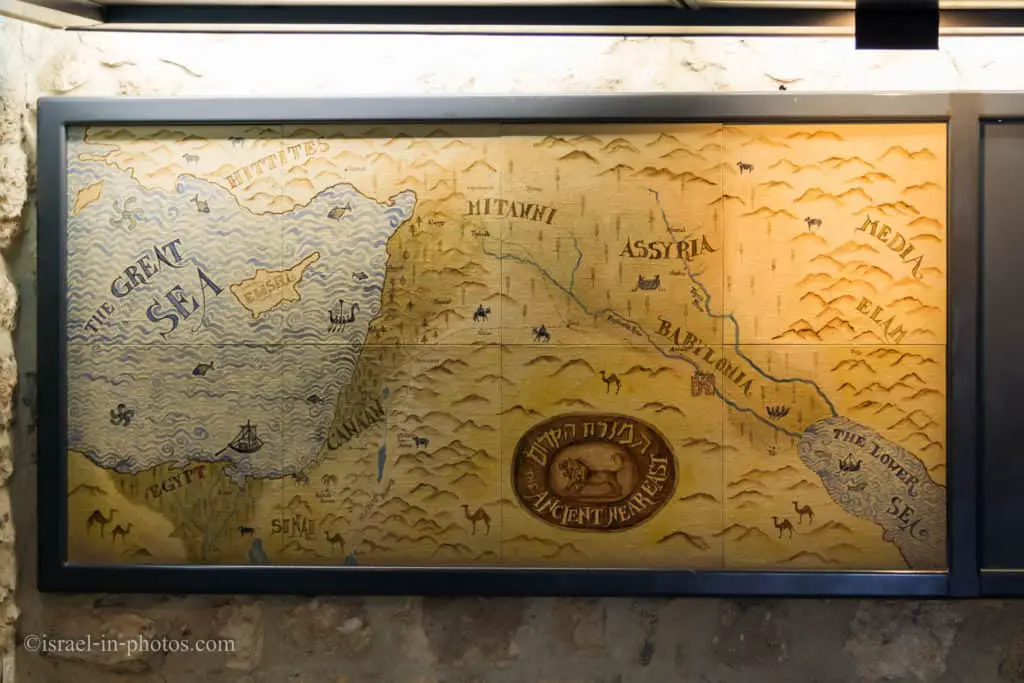
Музей и кино
При входе на сайт, рядом с парковкой находится небольшой комплекс зданий. Дом, в который вы войдете, служит небольшим магазином, где можно купить сувениры., мороженое, и входные билеты. Затем вы можете исследовать близлежащие комнаты. Некоторые номера служат в качестве небольшого музея. В одной комнате показывают фильмы об этом сайте на разных языках, а еще есть небольшой музей и туалеты.
Кассир сказал нам, что исторический фильм о Мегидо на иврите начнется через пятнадцать минут, когда мы зайдем на сайт.. Таким образом, Я бы порекомендовал спросить о фильме на предпочитаемом вами языке (если гиды не упомянут об этом).
Так как у нас было некоторое время, чтобы убить, мы посетили музей.
В это время, лошади широко использовались и интегрировались в вооруженные силы. Вы можете найти останки двух конюшен в Тель-Мегиддо национального парка, но мы достигнем их позже.
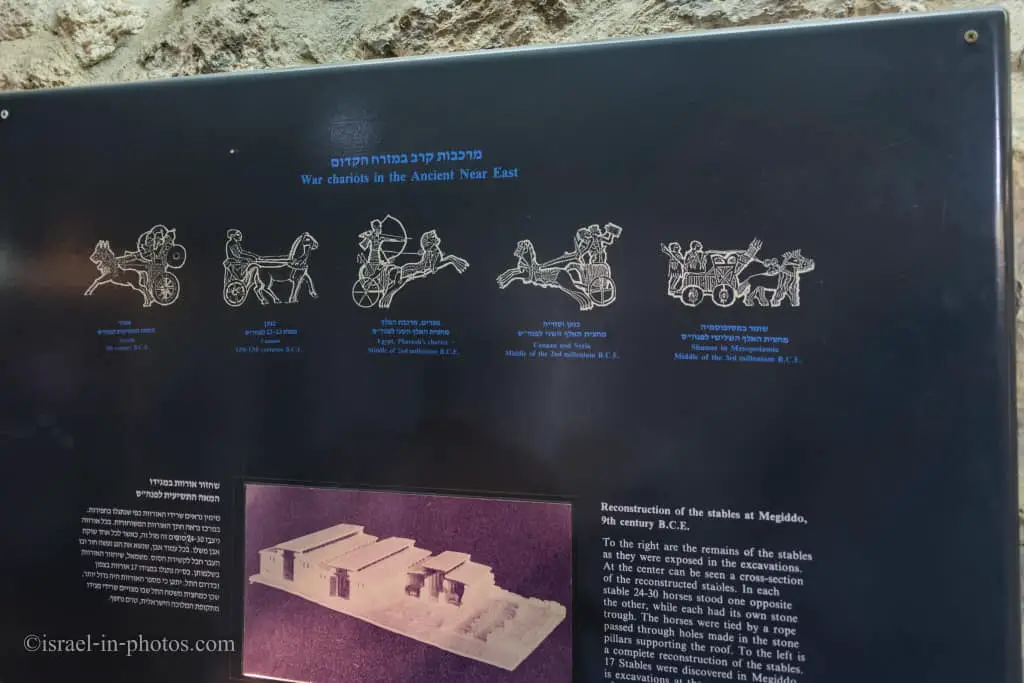
Мы посмотрели десятиминутный фильм об истории этого места, а затем немного поиграли с моделью города..

Вы можете найти кнопки, которые поднимают различные части модели и показывают нижние слои рядом с моделью..
Руины Тель Мегиддо
Посещение музея и кино заняло около получаса., а затем мы возглавили вне к развалинам. На карте выше есть номера для каждой достопримечательности и предлагаемый маршрут.. Если это ваш первый визит, советую придерживаться маршрута. И это в основном потому, что весь сайт не большой, и вы можете легко пройти его в течение двух часов.
После пятиминутной прогулки от музея, мы достигли точки #1.
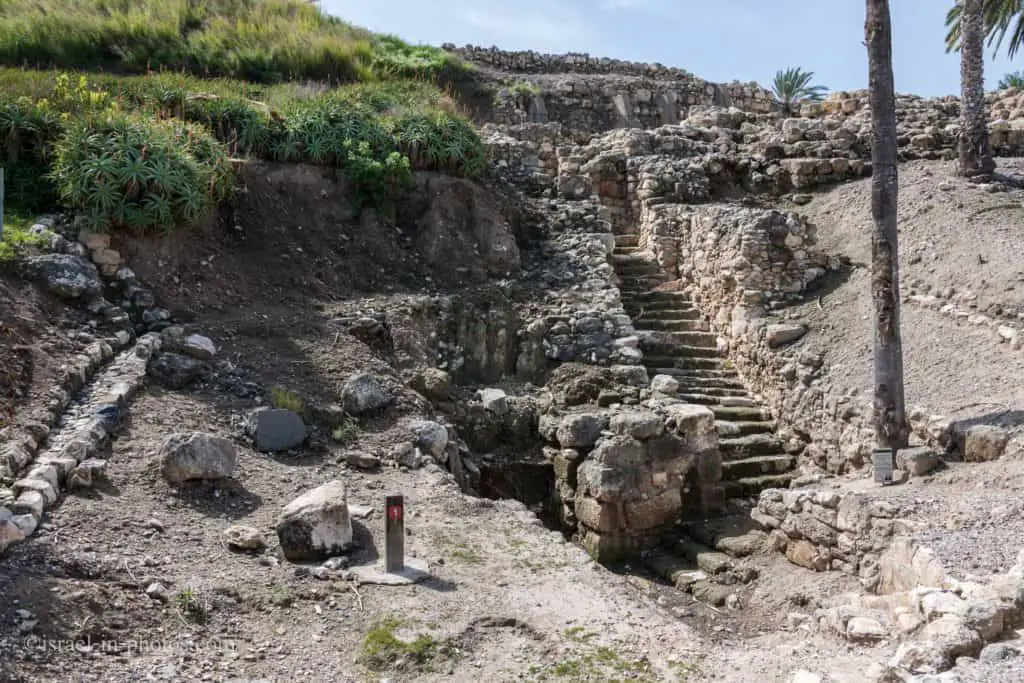
Число 1 представляет собой водный резервуар. Вы можете увидеть лестницу, ведущие к бассейну. Но, до сих пор не ясно, что это за источник воды.
Не уверен, что имя этого жука, но в один из наших визитов, мы видели их тысячи:
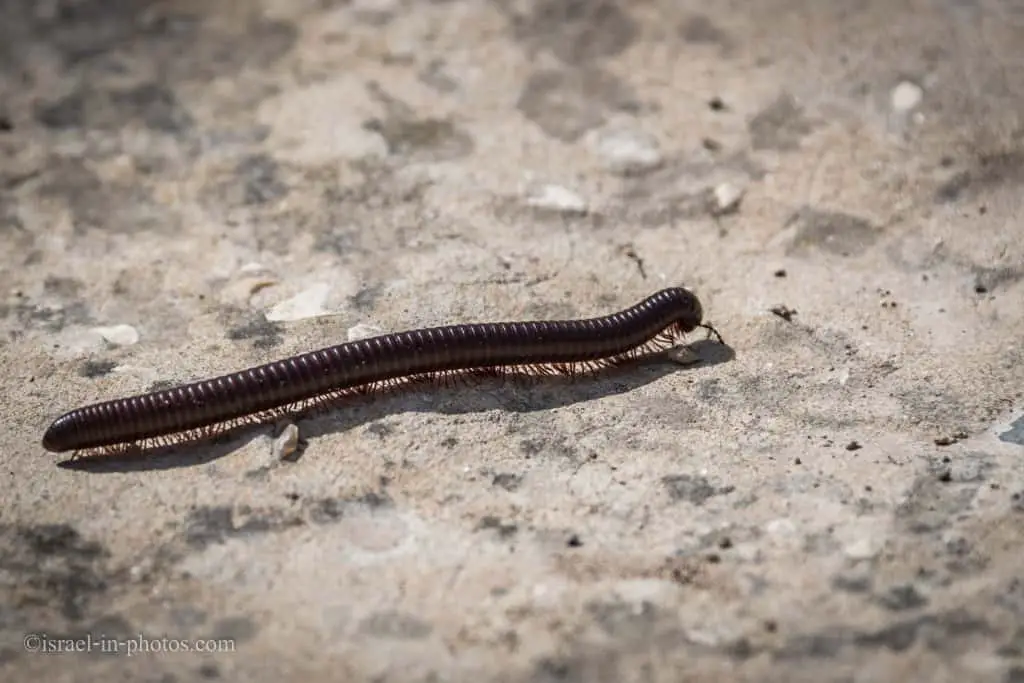
Ханаанский период

Городские ворота и Ханаанский дворец: главная находка ханаанского периода - городские ворота (15 век до н. Э.) И оригинальная каменная мостовая того периода, который ведет к ним.. Рядом с ним находится дворец Кананита - остатки большой структуры комнат, построенная вокруг центрального двора. В одной из комнат, эффектные предметы были найдены, в том числе золотых предметов, сотни единиц ювелирных изделий из слоновой кости, украшенной, и уборная вымощена оболочками.
Источник: если не указано иное, все исторические котировки были взяты с официального сайта.
Один интересный факт заключается в том, что Национальный Парк Тель Хацор и Тель Гезер имеют тот же тип ворот. Это приводит историков к выводу, что эти ворота построило одно и то же правительство., израильтянин администрация.
Ворота изнутри:
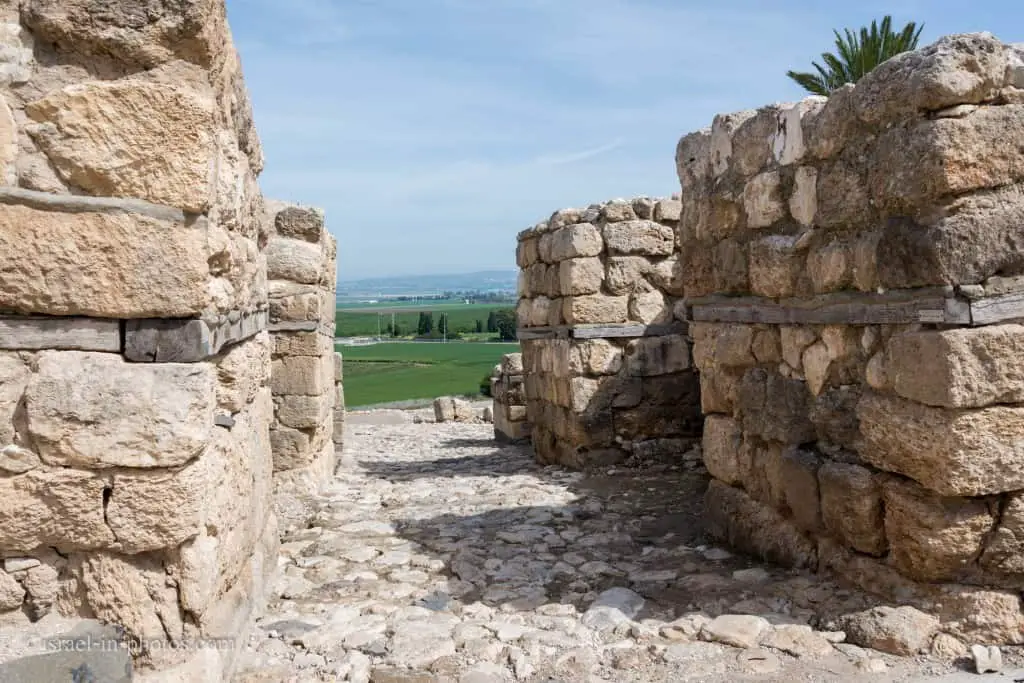
Как вы видете, есть комнаты по обе стороны от входа. Во время его строительства, город не имел стен. Таким образом, цель этих ворот не была защита. И вместо этого, это был ритуал один.

В соответствии с базовым уровнем, размер замка был 30×50 метров, и коллекция украшения из слоновой кости, который был найден здесь изображен высокий статус правителя.
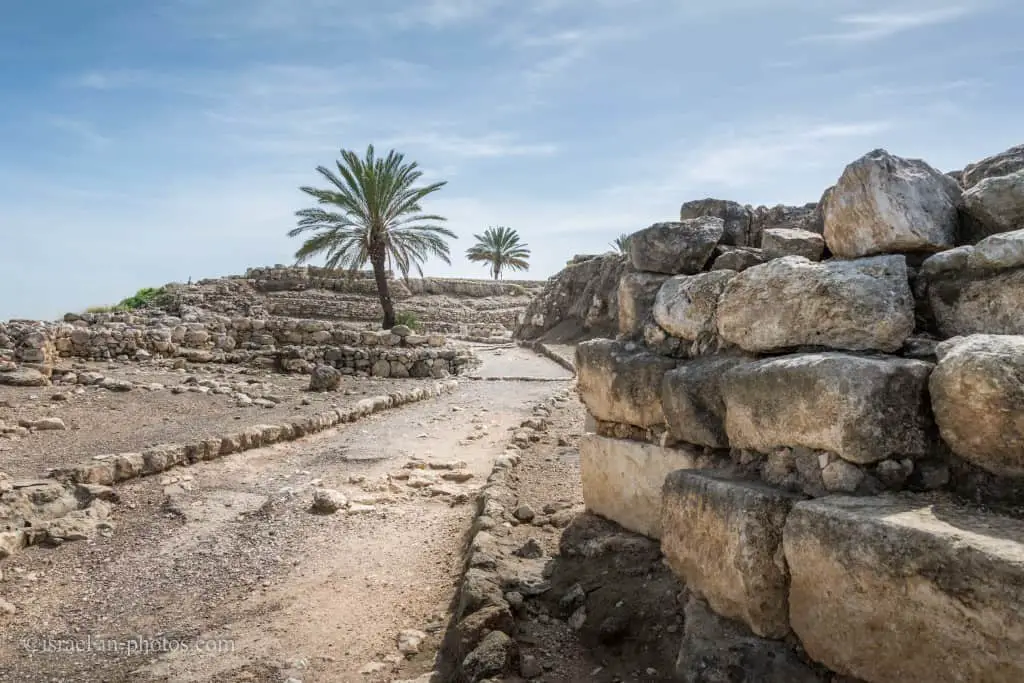
Северные конюшни
И мы достигли #6 – Северный Конюшни.

Исследователи обнаружили останки двух конюшен в городе. Это означает, что Мегиддо в ту эпоху был городом, основной целью которого была торговля лошадьми или поддержка армии всадников..
В Мегиддо, две устойчивые комплексы были извлечены из IVA Stratum, один на севере и один на юге. Южный комплекс содержал пять структур, построенных вокруг извести мощеный двор. Сами здания были разделены на три секции. К главному коридору, вымощенному известью, пристроены два больших вымощенных камнем прохода.. Здания были около двадцати одного метра длиной и шириной одиннадцать метров.
Отделить главный коридор от внешних проходов был ряд каменных столбов. Отверстия скучали во многие из этих столбов, так что лошади могли быть привязаны к ним. Также, остатки каменных яслях были обнаружены в зданиях. Эти питатели были размещены между колоннами, чтобы кормить лошадь. Предполагается, что каждая сторона могла бы держать пятнадцать лошадей, давая каждому зданию общую мощность в тридцать лошади. Здания на северной стороне города были похожи на их строительство. Однако, не было никакого центрального двора. Способность северных зданий была около трехсот лошадей вообще. Оба комплекса мог держать от 450-480 лошадей вместе взятых.
Источник: Википедия
Храмовая зона

Исследователи не раскопали эту область до самого низкого уровня. Они нашли 20 слои различных городов. И в храме в районе, они видели разные храмы разных периодов.
Храмовая территория: интересное место в “большой раздел” раскопки ранних археологических экспедиций в Мегиддо. В этой области, были найдены самые ранние останки сайта. Храмы были использованы в качестве ритуальной площадки для некоторых 2000 лет, до поселения израильтянами (12 век до н.э.). В большом разделе, который был раскопан вплоть до коренных пород, больше, чем 20 были обнаружены слои поселения.
В правой части следующей панорамы, видны остатки круглой платформы (диаметр платформы 8 метров). Археологи нашли множество костей животных, означая ханаанские человек провели множество ритуалов на этой платформе.

А это #15. Сможете угадать, что это?
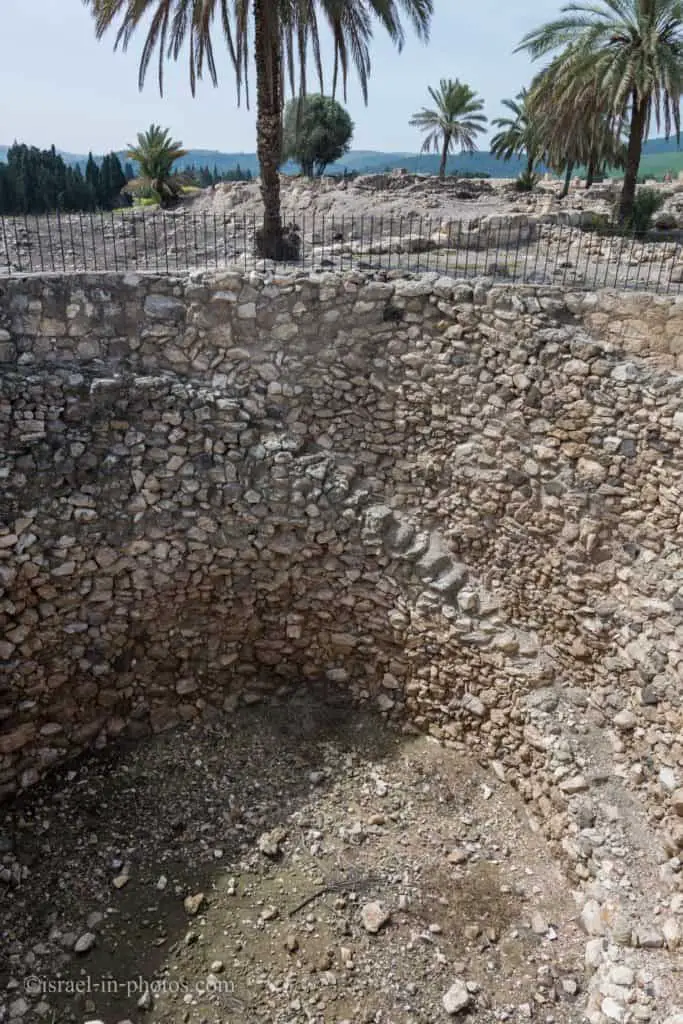
Это большой склад (высота: 7 метров, диаметр: 11 метров). Он имеет два набора лестниц (вы можете увидеть один из них на фото).
Широкий вид на склад:
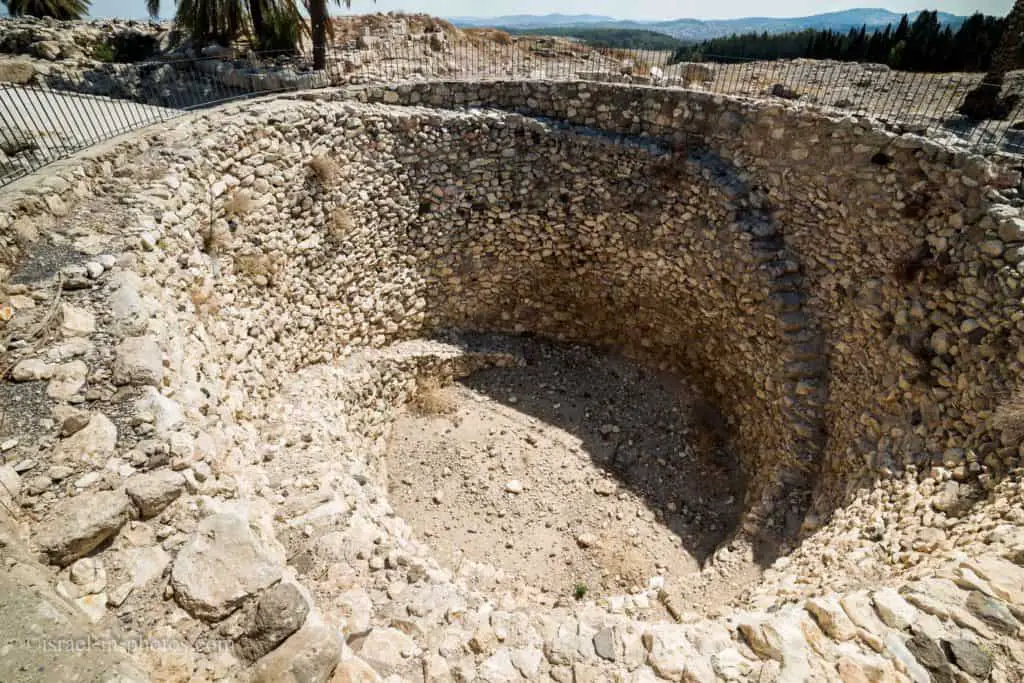
Во время земляных работ, Исследователи обнаружили остатки пшеницы среди стеновых камней. Это привело их поверить, что это было для хранения зерна. При таком размере, Вы можете хранить 1,000 тонн зерна.
Хранилище, вероятно, было построено одним из последних израильских королей., и некоторые считают, что это было сделано вместе с конюшнями, чтобы кормить лошадей..
Храм области с другой стороны:

Обзор долины Изреельскую.

Вот остатки административного здания израильского периода (# 11)..

Остатки жилого дома израильского периода (#13):

А это южные конюшни (#16). На самом деле, на фотографии, можно увидеть часть конюшни и вход в нее:

Как вы видете, Археологи частично восстановлено одно здание. Первоначально, было пять таких зданий.
Система водоснабжения
И теперь мы достигаем, по-моему, наиболее впечатляющее сооружение в Мегиддо, Водная система (#20):

Система воды началась, вероятно, в качестве резервуара в день царя Соломона, когда путь между параллельными стенками привел к роднику за пределами городских стен. Потом, по-видимому, во времена Ахава, более сложная система была построена, чтобы скрыть пружину и позволить людям брать воду, не выходя из стен города.
Система включает в себя 25-метровый глубокий вал в коренных породах. Внизу, 70-метровый, 3-метровый тоннель был прорыт. Пол шахты был ниже пружины, позволяя воде вытекать из пружины к валу, где люди могли бы сделать воду. Стена была построена, чтобы скрыть расположение пружины.
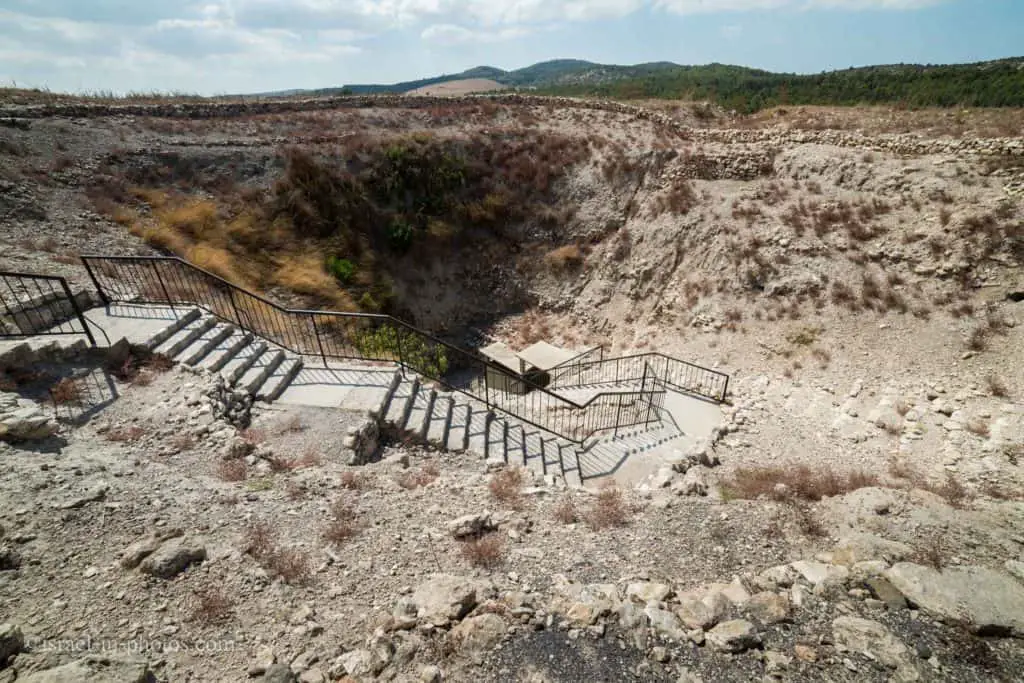
Бетонные лестницы современные. А если внимательно посмотреть на камни справа, вы увидите старинную лестницу, ведущую вниз.
Благодаря осадной возможности, люди в Мегиддо нужен доступ к воде. Таким образом, в течение периода Израильтянского, водная система была построена. Поехали 25 метров вниз:

и еще несколько:

При достижении дна, вы увидите 70 метров туннель:
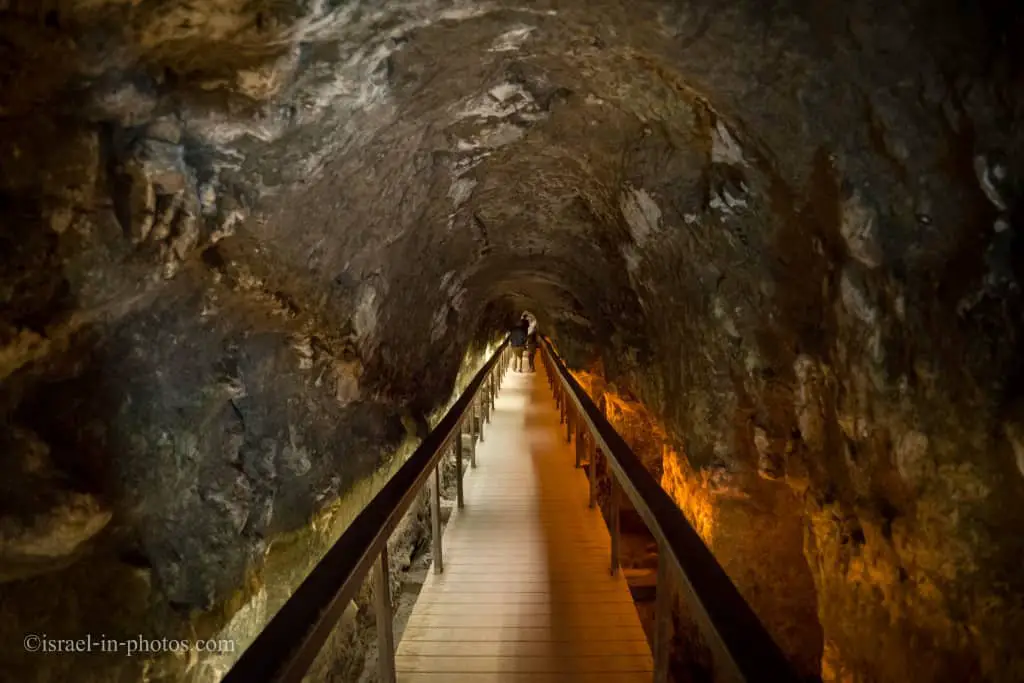
Туннель ведет к роднику, расположенному за городом.. Сам вал находится под небольшим углом, так вода потечет в траншею.

Выход из туннеля был закрыт гигантской стеной, покрытой грязью (для маскировки)..
Мы прошли через выход, а затем пошли по дороге обратно к въезду в Тель-Мегиддо.. Эта прогулка по парку взяла нас 10 – 15 минут.

Самая ранняя христианская мозаика в Израиле
Национальный парк Тель-Мегиддо расположен недалеко от перекрестка Мегиддо (дороги #65 и #66). На другой стороне того же перекрестка, вы можете увидеть тюрьму Мегиддо.
Недавно археологи обнаружили в этой тюрьме потрясающую мозаику.. Считается, что это самая ранняя христианская мозаика в Израиле.. Эта мозаика - часть римского лагеря., и это с 3 века. Он был построен до того, как римляне приняли христианство (император Константин издал Миланский эдикт в 313 н. э., принявшие христианство, и десять лет спустя, она стала официальной религией).
Есть планы перенести тюрьму в другое место и создать новый парк вокруг этой захватывающей находки.. Но коронавирус приостановил этот процесс. Таким образом, тем временем, мы видим это только в следующих новостях:
Распространенные вопросы
Мы посетили Мегиддо несколько раз сам, и в ряде других случаев, мы соединили туры. Мне больше нравились наши посещения, когда мы присоединялись к турам. Так как там очень много истории и археологических пластов, Предлагаю присоединиться к туру. Я видел два вида туров. Первый ориентирован на христианство (со многими цитатами из Библии)., а второй - археология и история. Я упоминаю об этом, так как лучше знать это, прежде чем присоединиться.
Мы присоединились к бесплатным турам волонтеров (упомянутых выше), которые относятся ко второму типу. Также, см. выше предложение от Бейн Харим.
Армагеддон представляет собой сочетание двух слов: Хар Мегиддо. Хар на иврите означает гора или, в нашем случае тел.. Таким образом, Армагедон означает Тель Мегиддо..
Нет единого мнения относительно того, что означает слово Мегиддо.. Википедия говорит, что Мегиддо означает “Рассказ губернатора,” но нет ресурсов, и я не нашел какой-либо другой сайт, который поддерживает эту теорию.
Мегиддо был завоеван более 20 раз. Таким образом, люди считали, что если будет конец мировой войны, это, вероятно, было бы в Мегиддо.
Вы можете посетить дополнительные Национальные Парки И Заповедники или проверить Планировщик поездки в Израиль для дополнительных достопримечательностей в этой области. Другой вариант, чтобы проверить близлежащие достопримечательности на карте в начале этого поста.
Армагеддон появляется только один раз в греческом Новом Завете., в Книге Откровения 16: 16: “И они собрали их на месте, которое на иврите называется Хармагедон.”
Мегиддо расположен в Нижней Галилее между Афулой., Йокнеам, и Умм аль-Фахм.
Резюме
Мегиддо Национальный парк не большой один. И в среднем, посещения заняли у нас около двух с половиной часов. Но несмотря на его размер, это является важным местом из исторических и религиозных точек зрения.
Кроме того, меньший размер делает его пригодным для посещения с детьми. Таким образом, если вы находитесь в области, Я рекомендую остановиться там с семьей или без. Кроме того, проверить на официальном сайте для бесплатных туров, и присоединиться к одной из них.
Вы когда-нибудь были в национальном парке Тель-Мегиддо? Расскажите нам о своем опыте в комментариях ниже.
Это все на сегодня, и мы увидимся в будущих путешествиях!
Следите за обновлениями!
Дополнительные ресурсы
Вот несколько ресурсов, которые я создал, чтобы помочь путешественникам:- Планировщик поездок с достопримечательностями и маршрутами - страница которая поможет вам создать идеальный маршрут путешествия.
- Какое лучшее время для посещения Израиля? Чтобы ответить на этот вопрос, мы учтем погоду, цены, каникулы, фестивали, и многое другое.
- Информация и советы для туристов в Израиле ответит на самые распространенные вопросы туристов об Израиле (в том числе о безопасности, паспорта, погода, валюта, опрокидывающийся, электричество, и многое другое).
- Национальные парки и заповедники Израиля включить полный список, Топ десять, карта, билеты (Израиль Пасс, Матмон, комбо), и кемпинги.
- Если вы ищете вещи, чтобы сделать, вот страницы для Иерусалим, Тель-Авив, Хайфа, Галилейское море, Акко, Эйлат, Назарет, Цфат, и Махтеш Рамон.






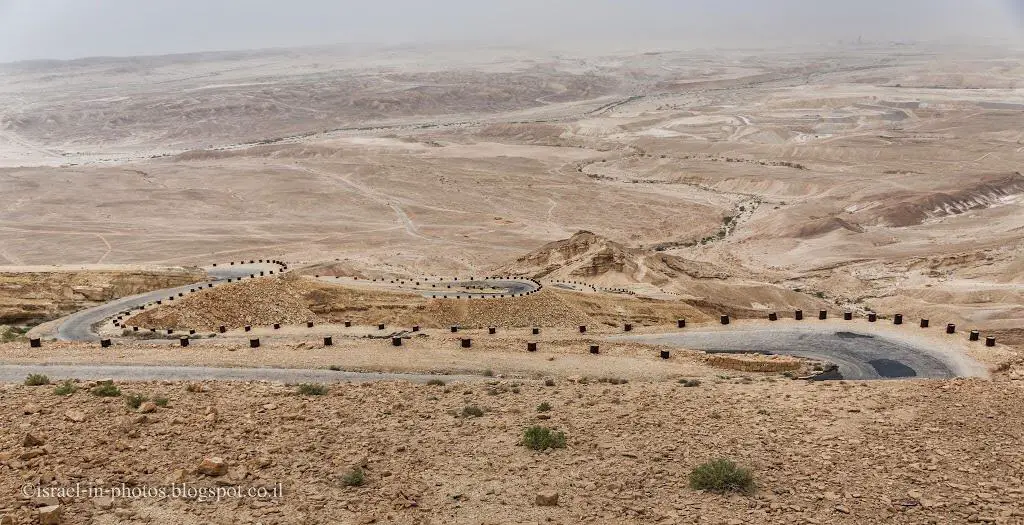


Боа тарде Амиго (a)
Boa tarde amigo (a), gostaria s' fosse possivel se vcs poderia me enviar essas fotos gostaria de imprimir elas ou enviar esse artigo em pdf no meu e-mail
Добрый день Ренато,
Я послал вам ответ по почте.
Шалом – Я планирую приехать с американской группой 15 или так в этом августе. Нужно ли нам покупать билеты заранее? У нас не будет гида, так есть ли доступ к пешеходной экскурсии или аудиогиду? И, мы можем просто появиться, или нам нужно сделать заказ заранее? Большое спасибо, Эрик Хеффлер, Каменный хребет, Нью-Йорк, США
Шалом Эрик,
Нет, покупка билетов заранее не требуется. Билеты можно купить на входе в национальный парк..
На входе есть вступительный фильм (на разных языках), и предлагаю не пропустить. Во время наших посещений аудиогидов не было., но изредка были бесплатные экскурсии волонтерами. Вы можете связаться с Управлением национальных парков Израиля по адресу: gl.megido@npa.org.il и спросите, будет ли экскурсия в день вашего визита.
Да, ты можешь появиться, но всегда рекомендуется делать предварительный заказ (особенно если вы приезжаете в выходные или праздничные дни). Если вы не бронируете, вход по бесплатным местам.
Вы можете сделать заказ на https://en.parks.org.il/reserve-park/tel-megiddo-armageddon-national-park/ и в большинстве национальных парков, вам не нужно выбирать временной интервал (бронирование действует на весь день).
Здравствуйте! Слышала по радио, что в ближайшие выходные у вас будут очень интересные мероприятия. Можно подробности? Спасибо
Привет,
В пятницу будут туры в 10:00 и 12:30. Вот дополнительные подробности: https://fe.sales.parks.org.il/product-page/191